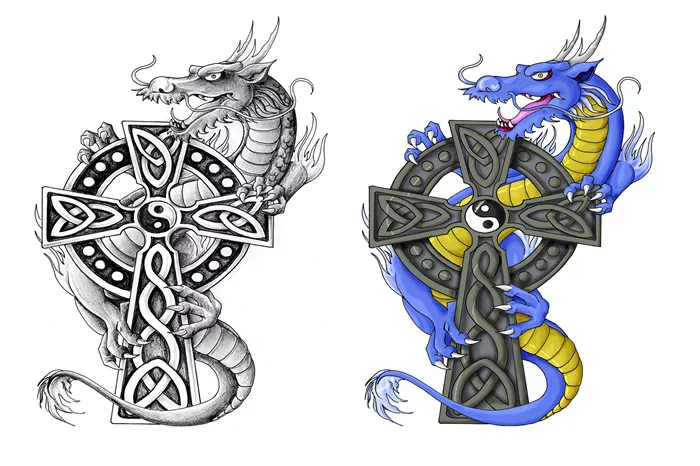The Celtic dragon is a mesmerizing emblem deeply entrenched in ancient folklore, imbued with layers of meaning and symbolism. From its origins in Celtic mythology to its contemporary representation in art and tattoos, the Celtic dragon continues to captivate the imagination of many. In this comprehensive exploration, we delve into the rich tapestry of significance behind this mythical creature, uncovering the essence of what the Celtic dragon truly symbolizes.
Origins and Mythological Significance
The roots of the Celtic dragon symbol can be traced back to the rich tapestry of Celtic mythology, where it occupies a prominent place in the pantheon of legendary creatures. In Celtic folklore, dragons were revered as powerful guardians and symbols of strength, wisdom, and protection.
According to mythological accounts, dragons were often associated with gods and goddesses, such as the Welsh dragon, which was linked to the ancient deity Dewi. These mythical beings were believed to possess extraordinary powers, capable of bringing both blessings and curses upon those they encountered.
One of the most renowned tales featuring a Celtic dragon is the legend of the red dragon and the white dragon, which symbolizes the eternal struggle between good and evil in Welsh mythology. This narrative underscores the dual nature of the Celtic dragon as both a formidable force of destruction and a benevolent protector.
Symbolism of the Celtic Dragon
At the heart of Celtic symbolism lies a complex tapestry of meanings, and the dragon serves as a potent symbol representing a myriad of concepts and ideals. Among the most prevalent interpretations of the Celtic dragon symbolism are:
Strength and Power: The Celtic dragon is often revered as a symbol of strength and power, embodying the indomitable spirit of the ancient Celts. Its majestic form and fearsome presence evoke a sense of awe and reverence, reminding us of our own inner strength and resilience in the face of adversity.
Wisdom and Knowledge: In Celtic mythology, dragons were believed to possess innate wisdom and knowledge, making them revered figures among gods and mortals alike. As symbols of wisdom, Celtic dragons inspire us to seek enlightenment and embrace the pursuit of knowledge in our lives.
Protection and Guardianship: As guardians of treasure and sacred knowledge, Celtic dragons are revered for their protective qualities. In Celtic culture, it was believed that dragons served as custodians of the land, safeguarding it from harm and ensuring the prosperity of the community. As such, the Celtic dragon symbolizes protection, guardianship, and watchfulness.
Eternal Cycle of Life: The Celtic dragon is often associated with the eternal cycle of life, death, and rebirth. Its serpentine form and coiled tail evoke the image of an unending loop, symbolizing the cyclical nature of existence and the interconnectedness of all living beings.
Spiritual Transformation: In the realm of Celtic spirituality, the dragon is regarded as a symbol of spiritual transformation and metamorphosis. Just as the dragon sheds its old skin to emerge anew, so too are we called to undergo profound inner changes and spiritual growth on our journey through life.
Interpretations in Modern Culture
In contemporary culture, the Celtic dragon continues to hold sway as a potent symbol, albeit with new interpretations and adaptations. From literature and art to tattoos and popular media, the Celtic dragon remains a ubiquitous emblem of strength, wisdom, and resilience.
In the realm of tattoo artistry, the Celtic dragon holds a special allure for those seeking to imbue their body art with deeper significance and meaning. Tattoo enthusiasts often opt for intricate designs featuring Celtic dragons intertwined with Celtic knots, spirals, and other symbolic motifs, creating visually striking compositions that pay homage to ancient Celtic heritage.
Moreover, the popularity of the Celtic dragon in modern culture underscores its enduring relevance and timeless appeal. Whether adorning the pages of fantasy novels or adorning the skin of tattoo aficionados, the Celtic dragon continues to inspire awe and fascination, reminding us of the enduring power of myth and symbolism.
Celtic Dragon in Literary Works
“The Mabinogion” – This collection of Welsh prose tales from the Middle Ages features several stories involving dragons. One of the most famous is “Lludd and Llefelys,” which tells the tale of the two dragons fighting beneath the earth, representing the conflict between Britain and its invaders.
“The Red Dragon” (Y Ddraig Goch) – The Red Dragon is a prominent symbol in Welsh mythology and features prominently in various Welsh literary works, including poetry and prose. It represents the nation of Wales and its struggles for independence.
“The Dragon and the Raven” by G.A. Henty – This historical novel for young adults tells the story of the struggle between Saxons and Vikings in England. The protagonist, a Saxon boy named Edmund, encounters a dragon during his adventures, adding a fantastical element to the historical narrative.
“The Hobbit” by J.R.R. Tolkien – While not explicitly Celtic, J.R.R. Tolkien’s work is heavily influenced by Celtic mythology and folklore. In “The Hobbit,” the character Smaug the dragon guards a hoard of treasure beneath the Lonely Mountain, echoing themes found in Celtic dragon stories.
“The Dragon Riders of Pern” series by Anne McCaffrey – This science fiction/fantasy series features dragons as central characters. While not explicitly Celtic, the dragons in McCaffrey’s novels share similarities with Celtic dragons in their mythical significance and role as protectors.
Conclusion
In conclusion, the Celtic dragon symbolizes a myriad of concepts and ideals, ranging from strength and power to wisdom and protection. Rooted in ancient Celtic mythology, the Celtic dragon continues to captivate the imagination of many, serving as a potent emblem of resilience, transformation, and spiritual growth. Whether depicted in ancient folklore or contemporary art, the Celtic dragon remains a timeless symbol that transcends cultural boundaries and speaks to the universal human experience.

